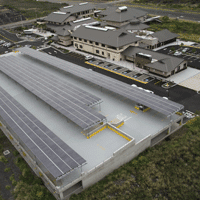Island
Towering at 13,679 feet, Mauna Loa is only 120 feet shorter than Mauna Kea, the highest point on the island of Hawaii. Not to be outdone, Mauna Loa, which translates to long mountain, is nearly 50 percent of the island’s total landmass. Due to its breadth, Mauna Loa is the primary weather regulator on Hawaii, keeping rain on its eastern half while its western side stays drier, calmer, and—during the day—subject to the unrelenting rays of the equatorial sun.
Kailua-Kona is a sunny, semi-arid coastal district situated near the island’s westernmost point. Respondent to substantial population growth over the past few decades and increasingly limited energy resources, civic officials on what Hawaiians call the Big Island had to find a way to continue serving their western constituents without draining public resources—or taxpayer bank accounts.
Site
Traffic is heavy on the Kealakehe Parkway, the main artery on the west side of the Big Island. In order to ease congestion, the Ane Keohokalole Parkway, a nine-mile, midsize road, is being built to cut straight through Kailua-Kona, fostering new residential and commercial development. To provide a public resource for future growth in the area, planning for the West Hawaii Civic Center began in 2007.
Completed in 2011, the WHCC is a $50 million, 80,000-square-foot building cluster that houses 15 county agencies, the mayor’s office, an amphitheater, and other services. Aided by its location on a virgin lava flow—what architect Brent Tokita, AIA, LEED AP, of Richard
Matsunaga & Associates calls “nature’s parking lot”—uninhibited exposure to the Pacific sun, and an average 10 inches of annual rainfall, developers treated the project as an opportunity to set a precedent for the district by utilizing sustainable building techniques and strategic capitalization of photovoltaic power.

The West Hawaii Civic Center has more than cultural events’ the complex has a zero-waste policy, bicycle parking, and electric-car charging stations.
Complex
The WHCC campus consists of eight separate buildings situated around a central courtyard in order to maximize airflow coming off the shore, situated two miles to the west. “In addition to the placement,” Tokita says, “we also worked hard to follow the regional vernacular style, which is a hybrid of agrarian and industrial forms.”
Will Rolston, energy coordinator for the County of Hawaii, adds that the project was especially important because it was the first one the county had completed using a design-build approach. As such, education played an integral part. “We wanted to minimize misunderstandings and ensure the whole team would be on the same page for accomplishing the sustainability goals of this project,” Rolston says.
The project’s most notable sustainable element is the 250-kilowatt photovoltaic array located on the top deck of the WHCC parking structure. Although it was originally intended for placement on all rooftops, the fragmented style of the campus suggested that a centralized array would prove to be most efficient. “Aside from having an ideal orientation, placing the array on top of the structure allows us to provide shade for vehicles in the structure,” Tokita says.
“By centralizing the array,” Tokita adds, “we didn’t have to run the AC/DC lines from the inverters back to the distribution room, which also allows the WHCC to better power the emergency backup generator.”
The array also marked another significant first for the county: a power purchase agreement (PPA). The WHCC needs 150 kilowatts of peak power during the day, which leaves an excess of 100-plus kilowatts, allowing the county to charge electric vehicles and generate revenue by selling excess wattage to the power company.
“We requested that Maryl Construction, our design-build partner, write the RFP, which included a pro forma PPA,” Rolston says of the agreement. The photovoltaic RFP had an open range for the size of the array (building loads were not yet known), but Rolston’s first responsibility as energy coordinator was to bolster the design-build process by naming the design-builder as the lead for the project, who was then able to work with the contractors and allow for streamlined bidding and installation of the photovoltaic and other functional systems.
“The agreement between the county and the power provider gives us a pool of cheap renewable energy and allows flexibility for how we use our energy,” Rolston says. Aside from providing power for routine building functions, the arrays also provide power to five hybrid Chevy Volts, which save the county drivers roughly three dollars per gallon. Rolston adds that the county is installing a 100-kilowatt battery to store renewable energy made during the day, which will hopefully provide nighttime energy. The center only needs 50 kilowatts at night, and the goal is to eventually hit net zero.
Tokita sums up the value of WHCC. “Consolidating these county offices and putting the energy under county control will greatly reduce their carbon footprint and energy usage,” he says. “Which is good for the county—and good for Hawaii.”

